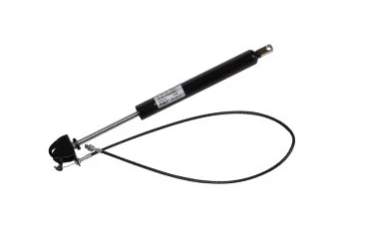If you are interested in our products ,please contact our team
In automobile, maritime, agricultural, and household springing application domains, adjustable gas springs offer significant advantages, particularly in which regulated damping is desired.
When contrasted to helical or leaf metal or synthetic springs, gas springs offer a relatively consistent force throughout their tension or compression stroke.
They can still be built with remarkable properties like dynamic damping and restricting.
In longitudinal settings, adjustable gas springs provide a dependable and long-lasting replacement to helical and leaf springs when used appropriately.
A basic gas spring is made up of an enclosed hollow cylindrical metal with quite a good surface hole, a firmly fitted piston with a measured bore, a piston rod, a specific limit of oil fill, and a highly compressed charged nitrogen gas.
The damping effect is described by the tremendous pressure gradient on the area of the piston rod directly.
Furthermore, the true spring force is produced by the increased pressure of the charged nitrogen gas impacting upon the differential areas between the top and bottom of the piston.
The thickness of the Piston rods is normally within 6 and 14 mm. To generate a resistance of 100 pounds with a piston rod thickness of around 10 mm, an operating pressure of almost 1400psi is required.
Oil or gas is discharged to the opposing end of the piston through an aperture in the piston to produce the damping effect.
Instead of charged gas and oil bursting outwards, a compression spring stretches at a regulated speed when released.

Due to the sheer underlying sturdiness of the cylinder-plunger (Piston rods) arrangement.
Gas springs are relatively long can be used for an extended period when compared to compressed coil springs.
The large percentage of adjustable gas springs sold are compression kinds which require a push force.
This means they are stretched when at rest and upon subjugation to compressive forces, it contracts, pushing the Piston rod through into cylinder.
The majority of adjustable gas springs can always be compressed to roughly 60% of its initial length.
Swiveling desk chairs use lockable kind of gas springs to lift or lower the seat, and then use the controlling handle to lock it in place.
In automobile and marine and other manufacturing industries, adjustable gas springs are widely employed to support engine covers, baggage chambers, and they also act as absorbers for sudden shocks and twist.
They're also found in relaxation coaches, and machine parts which are constantly subjected to tensile or compressive forces.
Firstly, Calculate the spring's maximum length when at rest and the intended spring force.
To avert the device from bending, the force must be applied in a straight line perpendicular to the gas spring's midline.
The piston rod and cylinder must also be insulated from impacts, indentations, and damages.
Finally, consider the applications of unique attributes like exterior lock and adjustable damping and how best they help in providing solution to suspension inadequacies.
Do not attempt to open, chop, or distort the adjustable gas springs because it is hazardous due to their incredibly high pressure.
Piston rods should never be scraped, filed, or coated and should always be thoroughly cleaned. Operating temperatures must be kept between -35 and +80 degrees Celsius.
With autonomous design, innovation and manufacturing capabilities, we offer expertise and manufacture of superb quality of adjustable gas springs.
Creating numerous tailored solutions for clients and considering customer satisfaction to be our firm's main purpose.
Feel free to contact us if you have any questions about gas spring production.